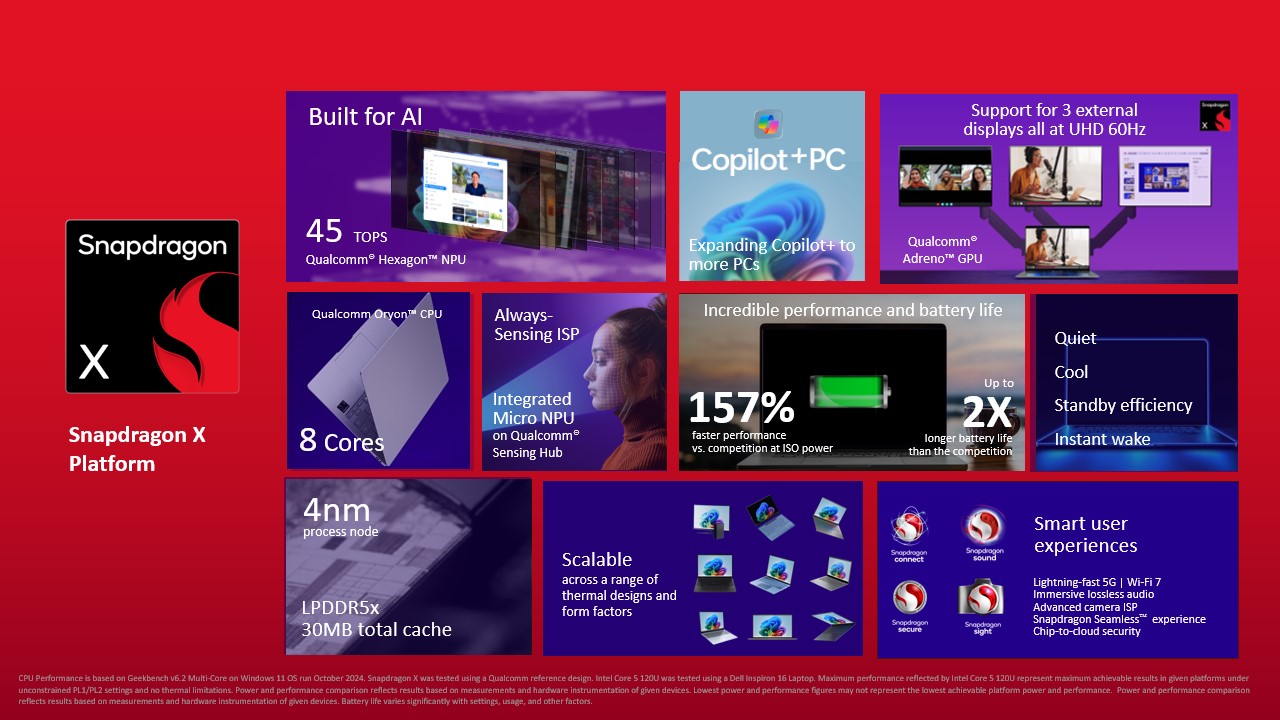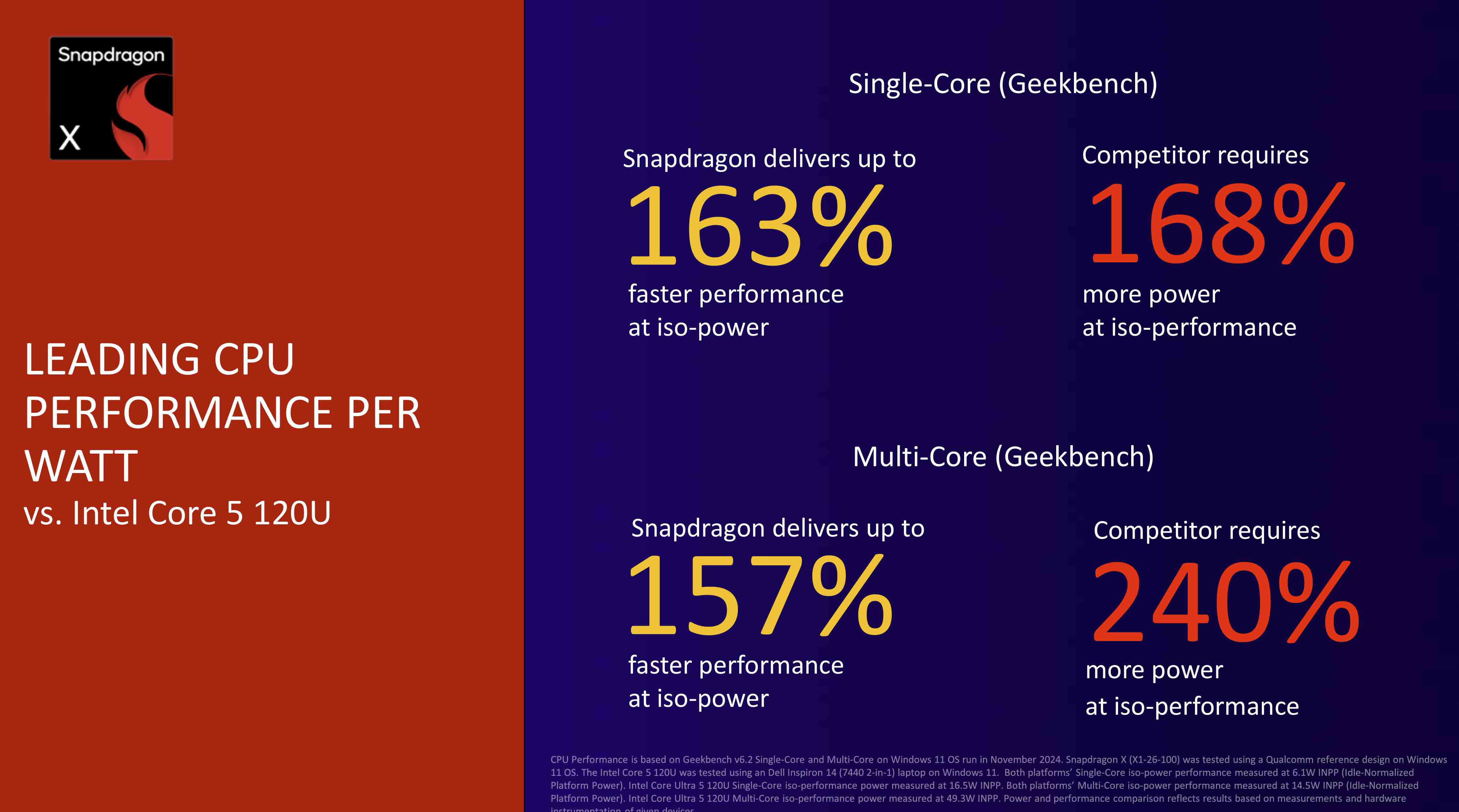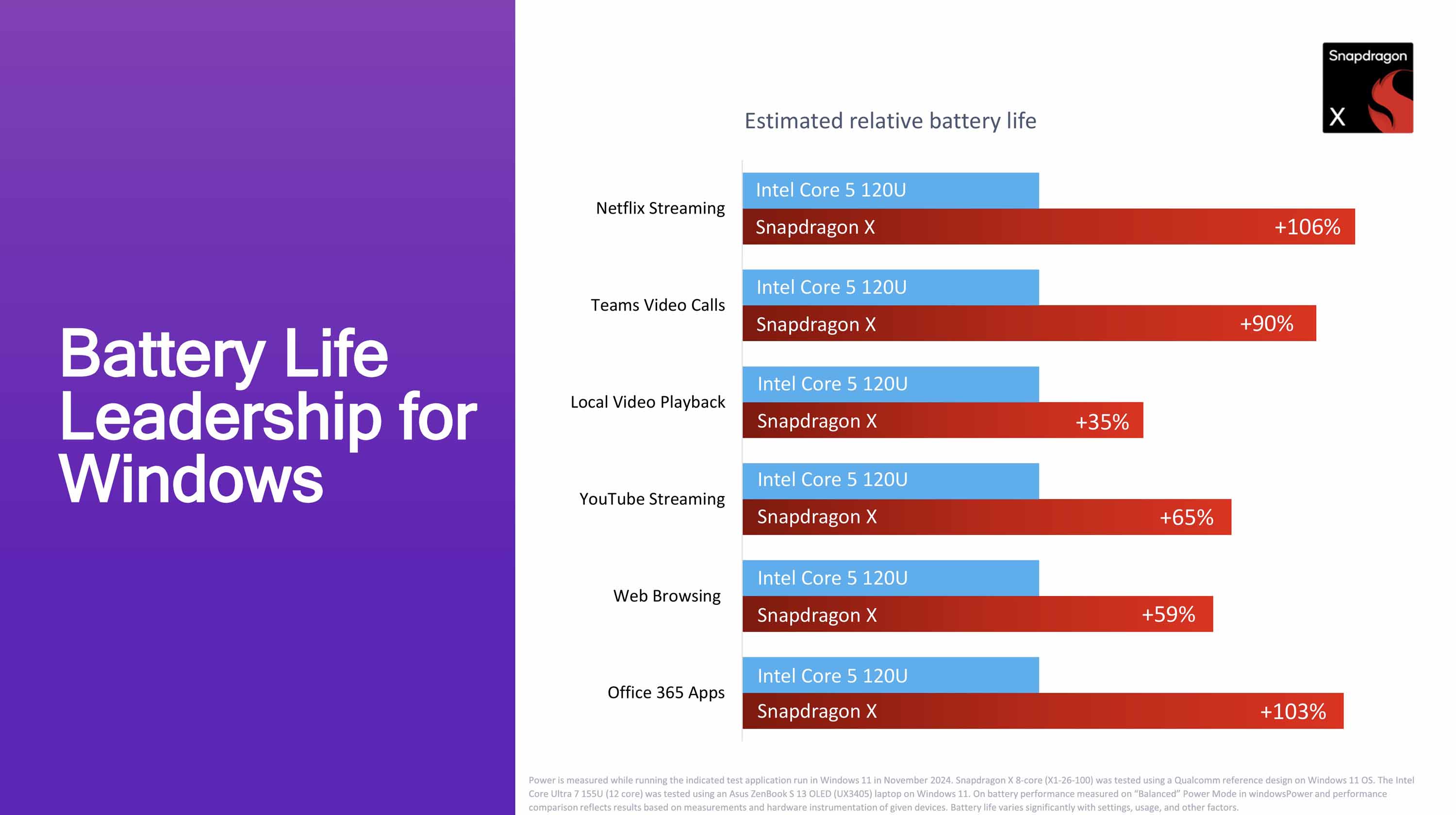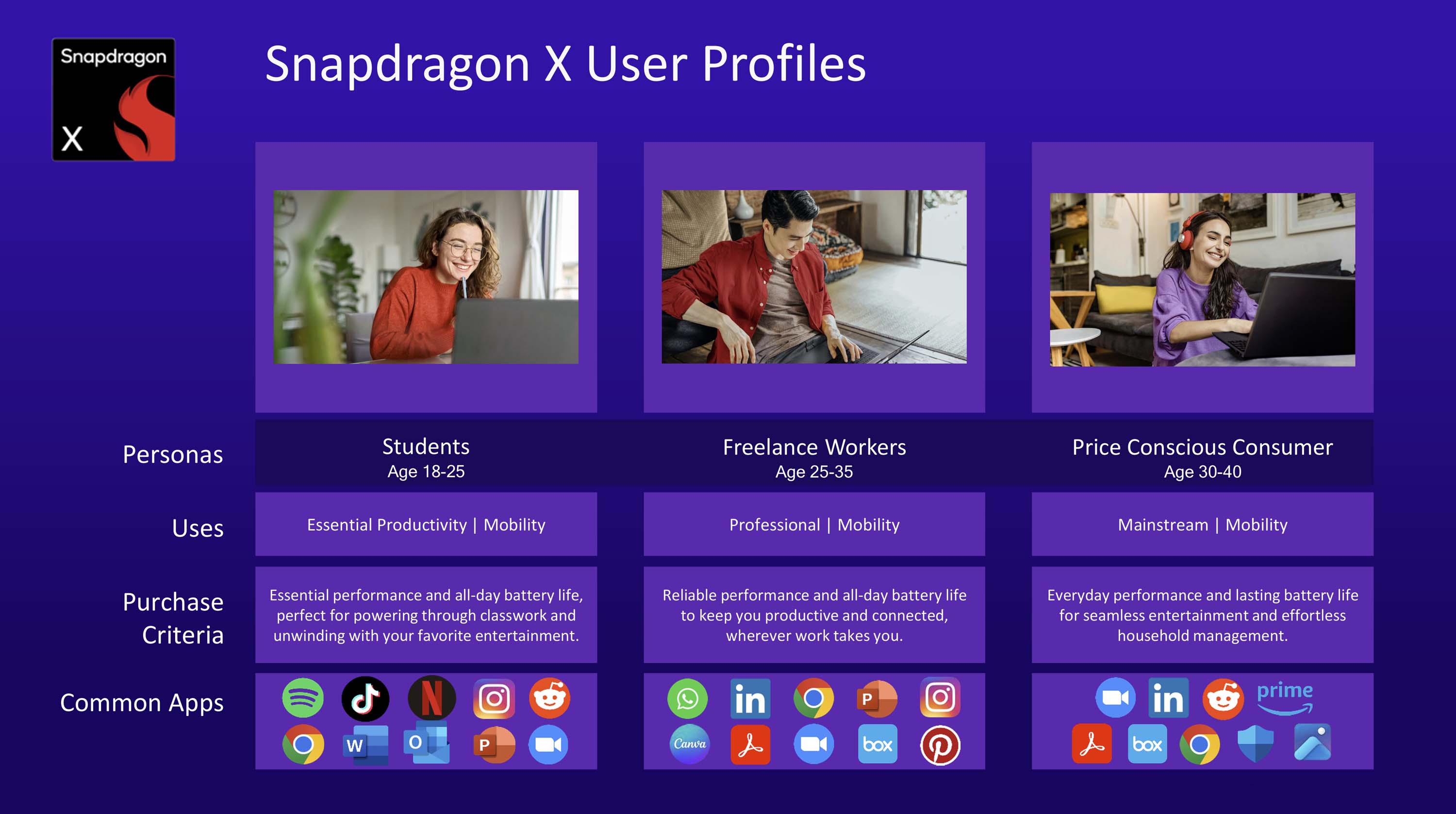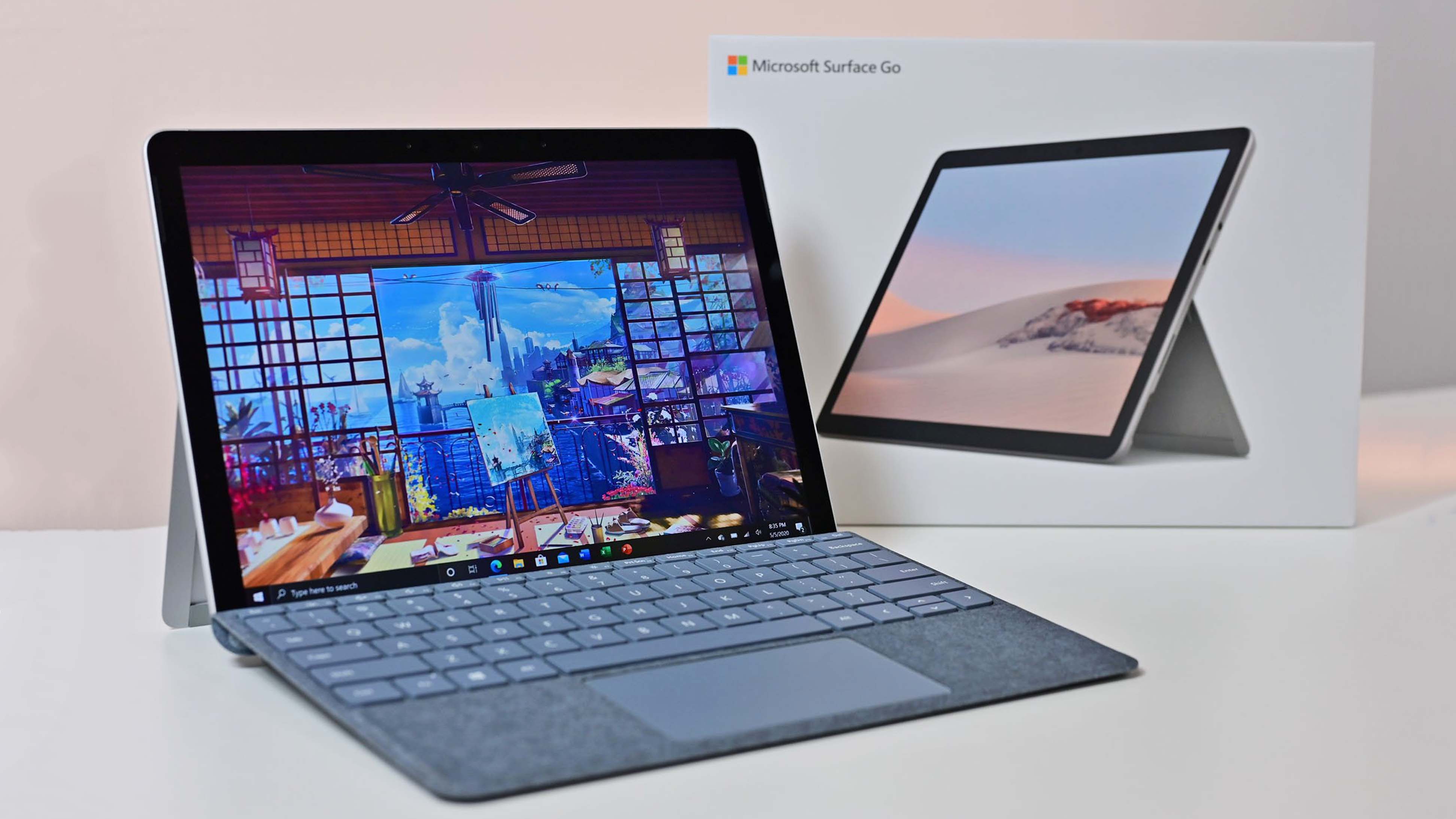Qualcomm has announced its new Snapdragon X chip in Las Vegas at the Consumer Electronics Show (CES) 2025. The new chip is the fourth addition to the Snapdragon X Series of Windows on Arm PC chips. The processor is aimed at “students, freelance workers, and budget-conscious consumers,” with laptops starting in the $600 range.
The Snapdragon X (X1-26-100) chip is a slightly toned-down Snapdragon X Plus design with the same 8-core count but maxes out at 3.0 GHz (CPU) with no boost and 1.7 TFLOPS (GPU). Meanwhile, the Snapdragon X Plus series ranges from 3.2 to 3.4 GHz with boosts up to 4.0 GHz for one SKU, and the GPUs range from 1.7 to 3.8 TFLOPs.
However, the new Snapdragon X chip boasts the same 45 TOPS neural processing unit (NPU), making it a full-fledged Copilot+ PC and AI PC with access to advanced AI functionality.
Since Qualcomm first announced its Snapdragon X Elite chip, I have noted that this platform is not a single processor, meaning the company can scale up or down via core count and clock speed. Qualcomm is focusing on the latter for CES 2025, and it’s an excellent move. Windows laptops in the sub-$800 range have typically suffered from terrible performance due to Intel and AMD’s lackluster performance in that range.
In addition to sporting 8-cores at 3.0 GHz, Snapdragon X also features optional 5G support, Wi-Fi 7, speedy 8448 MT/s LPDDR5x RAM, a “Sensing Hub” that offers human presence detection, USB4 (40Gbps), and Bluetooth 5.4, which are all advanced features typically found in more expensive Windows laptops.
How does Snapdragon X compare to other Snapdragon X chips?
Snapdragon X Plus comes in four versions ranging from 8 to 10 cores and varies in speeds with boost for short durations. The new Snapdragon X chip features 8 cores, a slightly lower clock speed, and no burst. Its GPU matches the lower-tier Snapdragon X Plus (XIP-42-100).
In my limited time with early hands-on experience with the Snapdragon X, Windows 11 felt very responsive and was certainly a big step up over some of Intel’s older budget chips.
| Platform | Part Number | Cores | Total Cache | Max Multi-core | Dual Core Boost | TFLOPS | NPU TOPS |
|---|---|---|---|---|---|---|---|
| Snapdragon X Elite | X1E-84-100 | 12 | 42 MB | 3.8 GHz | 4.2 GHz | 4.6 | 45 |
| Snapdragon X Elite | X1E-80-100 | 12 | 42 MB | 3.4 GHz | 4.0 GHz | 3.8 | 45 |
| Snapdragon X Elite | X1E-78-100 | 12 | 42 MB | 3.4 GHz | None | 3.8 | 45 |
| Snapdragon X Plus | X1P-66-100 | 10 | 42 MB | 3.4 GHz | 4.0 GHz | 3.8 | 45 |
| Snapdragon X Plus | X1P-64-100 | 10 | 42 MB | 3.4 GHz | None | 3.8 | 45 |
| Snapdragon X Plus | X1P-46-100 | 8 | 30 MB | 3.4 GHz | 4.0 GHz (Single-Core) | 2.1 | 45 |
| Snapdragon X Plus | X1P-42-100 | 8 | 30 MB | 3.02 GHz | 3.4 GHz (Single-Core) | 1.7 | 45 |
| Snapdragon X (NEW) | X1-26-100 | 8 | 30 MB | 3.0 GHz | None | 1.7 | 45 |
In the table above you can see all eight of the Snapdragon X Computer Platform chips and how they compare to each other with the new Snapdragon X (X1-26-100) at the bottom.
How does Snapdragon X compare to Intel?
While I need to do our own benchmarks, Qualcomm compared its Snapdragon X (X1-26-100) chip to Intel’s early 2024 Core 5 120U (10 cores, up to 5GHz) processor.
Qualcomm used a reference-design laptop for its chips and a Dell Inspiron 14 2-in-1 (7440) for Intel, which costs $750 and has 8GB of RAM.
The short version is that Snapdragon X appears to be 2x more powerful than the same-class Intel Core 5 while using 2x less power.
Qualcomm claims its chip is 163% faster (at iso-power) in Geekbench 6.2 single-core and 157% faster (at iso-power) in multi-core performance. Moreover, Qualcomm notes that Intel’s Core chip requires 168% (single core) and 240% (multi-core) more power at iso-performance compared to the new Snapdragon X.
Likewise, the Qualcomm GPU is claimed to be 319% faster at iso-power than the Intel Graphics GPU, which also requires 258% more power (at iso-performance) compared to the Snapdragon X.
Qualcomm also notes that the Intel Core 5 120U and AMD Ryzen 5 7540U budget processors have zero support for an NPU, whereas Snapdragon X’s 45 TOPS NPU makes it a true AI PC.
The company also shared some other benchmarks, noting that in Google Chrome, the Snapdragon X chip gets 2.2x performance per watt vs. Core 5 and 2.8x the performance per watt in Microsoft Office.
Why is Snapdragon X a big deal?
While plenty of Windows 11 laptops are in the $600 to $700 range, their performance has always been poor due to Intel’s non-aggressive strategy in that market segment. Battery life was also never a strong point.
Moreover, despite tech media focusing on laptops costing $1,000 and more (ooh, shiny!), the overwhelming number of laptops sold yearly is solidly in the $600 to $800 range. Indeed, according to Grand View Research, “The USD 501 to USD 1000 segment held a market share of 35.8% in 2022 and is expected to dominate the market by 2030.“
The reason? A combo of “consumers seeking laptops suited for personal and professional uses,” Windows 10 support ending, and, you guessed it, because processors in this range are getting better, letting people do more without spending more.
Additionally, the fact that Copilot+ PCs won’t be just for “premium” users will massively help expand AI in PC software for everyday users. The AI revolution will be for everyone; forget “trickle down.”
By choosing an Arm-architecture laptop that uses Snapdragon X, consumers should experience satisfying performance, especially compared to Intel and AMD options.
Likewise, battery life should be markedly better with little or no fan noise.
In short, Qualcomm’s Snapdragon X will, at the very least, cause some disruption in the budget-focused PC market, which could lead to more engaging competition from Intel or AMD. That’s always a good thing for consumers.
Which PC makers are adopting Snapdragon X?
So far, Acer, ASUS, Dell Technologies, HP, and Lenovo are all releasing laptops with the Snapdragon X Series (including Plus and Elite), but we’ll have to wait until later this week to learn which companies are announcing new Snapdragon X laptops at CES 2025.
(Spoiler: What is likely the “Windows Central best Windows laptop at CES 2025” also features the Snapdragon X.)
Broadly speaking, Qualcomm notes that “Snapdragon X Series continues to gain traction with now over 60 designs in production or development with more than 100 coming by 2026 from leading OEMs …”
Who is Snapdragon X for?
Qualcomm claims Snapdragon X is ideal for “students, freelance workers, and budget-conscious consumers.”
When will Snapdragon X Windows laptops be available?
You won’t have to wait long, as some Snapdragon X laptops start shipping in January 2025.
How many external displays does Snapdragon X support?
The Snapdragon X’s Adreno GPU supports up to 3 external UHD (3840 x 2160) displays simultaneously with a 60Hz refresh rate.
Could Microsoft use Snapdragon X in its Surface Go line?
While we cannot confirm or deny whether it’s happening, Microsoft could definitely use Snapdragon X in its more affordable Surface Go 4 and Surface Laptop Go 4 in 2025, assuming Microsoft is going to make those PCs.
The performance jump between the previous models and Snapdragon X would be massive.
Surface Go 3 used an Intel Core i3-10100Y (from 2021), and Surface Laptop Go 3 relied on an Intel Core i5-1235U (from 2022). Neither had great performance (though Surface Laptop Go 3 started approaching OK performance).
Personally, I’d love to see this Qualcomm chip in the Surface Go series. It’ll be a game-changer for these otherwise outstanding PCs.
Will Snapdragon X laptops have a fan?
As always, OEMs have full control over the Snapdragon X’s power profile and can design systems that require a fan for cooling, no fan (but vented aka passive cooling), or a sealed system with no fan. Such decisions depend on how aggressively the OEM wants to make its laptop for performance.
What comes next?
Expect to hear more about Snapdragon X this week at CES 2025 as we conduct deep dives with Qualcomm and get hands-on experience with new laptops featuring the silicon.


